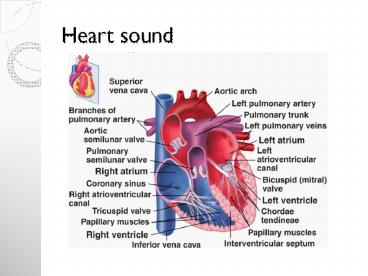Heart sound - PowerPoint PPT Presentation
1 / 22
Title:
Heart sound
Description:
Heart sound Area Of Auscultation Area Of Auscultation Pulmonary valve second intercostal space, left upper sternal border Aortic valve second intercostal space ,right ... – PowerPoint PPT presentation
Number of Views:741
Avg rating:3.0/5.0
Title: Heart sound
1
Heart sound
2
Area Of Auscultation
3
Area Of Auscultation
- Pulmonary valve second intercostal space, left
upper sternal border - Aortic valve second intercostal space ,right
upper sternal border - Mitral valve fifth intercostal space , left
midclavicular line - Tricuspid valve fourth intercostal space, lower
left sternal border
4
What we hear ?
- We have all heard the heart make the usual
sounds. - LUB----------DUB
- Lub is the first sound or S1
- Dub is the second heart sound or S2
5
First heart sound S1
- The lub in the lub dub.
- This sound is primarily because of the closing of
the bicuspid and tricuspid valves. - Anatomically they are located between the atria
and the ventricles - They close because the ventricles contract
- The Pulmonic and Aortic valves are opening and
blood is being forced into the arteries - Its maximum intensity is at the apex
6
S1 abnormalities
- Loud S1
- Mitral stenosis
- Tachycardia
- Soft S1
- Mitral regurgitation
- Heart failure
7
Second heart sound S2
- S2 is the dub in the lub- dub
- The sounds are because of the closing of the
Pulmonic and Aortic valves as the pressure from
the arteries is greater then the pressure in the
ventricles. - This is the end of systole
8
S2 components
- Has two components A2 and P2
- Inspiration decreases intrathoracic pressure,
increases RV filling - RV is relatively weak, and an increase in filling
results in slower emptying - Inspiration delays P2, causing audible splitting
of S2 - P2 localized to pulmonary area while A2 audible
all over the pericardium with max. intensity at
aortic area
9
S2 abnormalities
- Loud P2
- Pulmonary hypertension
- Soft P2
- Pulmonary stenosis
- Loud A2
- Systemic hypertension
- Soft A2
- Aortic stenosis
- Aortic regurgitation
10
Split abnormalities
- Usual splitting
- normal in children and young adult
- Rt bundle branch block
- Pulmonary hypertension
- Fixed splitting
- Atrial septal defect
- Reversed splitting
- Lf bundle branch block
- Sever aortic stenosis
11
Systole
- The time between the S1 and S2 sounds is
- Lub------------Dub
- The ventricles contracting
- Blood flowing from the heart to the lungs and
body - Blood flowing across the Pulmonic and Aortic
valves
12
Diastole
- The time between S2 and S1 is
- Dub----------Lub
- The blood is flowing from the atria to the
ventricles. - The blood flowing across the bicuspid and
tricuspid valves. - The atrial contraction also occurs now
13
(No Transcript)
14
Third heart sound S3
- Is a low pitched early diastolic sound best heard
with the bell at the apex. - also called a protodiastolic gallop, ventricular
gallop - Coincides with rapid ventricular filling after
the AV valves. - It is best heard with the bell-side of the
stethoscope at the apex of the heart - Causes
- Normally in Children and during pregnancy
- Pathological
- LVF
- MR
15
Fourth heart sound S4
- Low pitched sound occurs at late diastole due to
atrial contraction if ventricles are non
complaint. Just before S1 - Called a presystolic gallop or atrial gallop
- It is always pathological
- Causes
- Hypertension
- Cardiomuopathy
- AS
16
Murmurs
- These are abnormal sound and are longer duration
s compared to heart sound produced due to the
turbulence of blood flow through valves - Three Types
- Systolic murmurs
- Diastolic murmurs
- Continuous machinary murmur
17
Ejection systolic murmur
18
Pansystolic systolic murmur
19
Mid-Diastolic murmur
20
Early diastolic murmur
21
Continuous machinary murmur
22
Thank You































